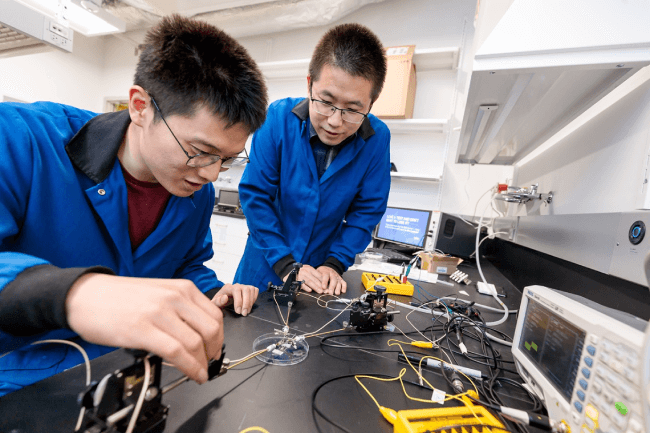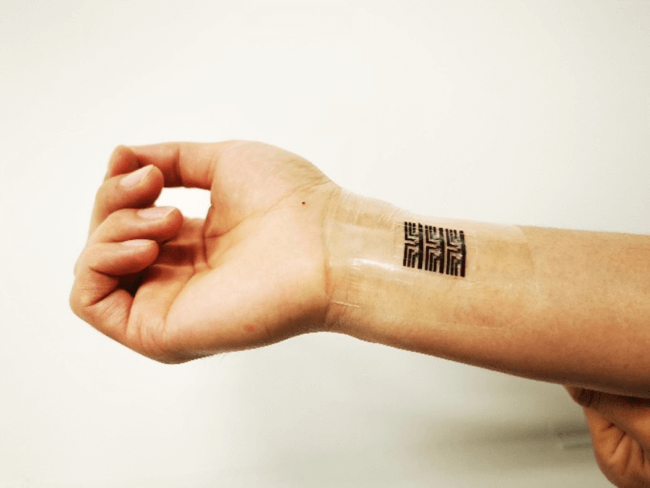New Fully Stretchable OLED Display Revolutionises Flexible Electronics
Insights | 24-04-2023 | By Robin Mitchell
Researchers have recently unveiled a groundbreaking stretchable OLED display that can be effortlessly curved around a wrist, folded in various directions, and wrapped around objects like a steering wheel. This article will explore the challenges faced by flexible electronics, delve into the innovative technology developed by the researchers, and discuss its potential impact on the future of flexible electronic devices.

Asst. Prof. Sihong Wang and PhD student Yahao Dai examine a wearable neuromorphic device (Photo by John Zich).
What challenges do flexible electronics present?
Flexible electronics, also known as flexible or bendable electronics, refer to electronic devices that can be bent, twisted, or contorted without damaging functionality. They offer a wide range of possibilities for applications such as wearable devices, flexible displays, and biomedical sensors. However, several challenges face the development and implementation of flexible electronics.
One of the primary challenges is the design and manufacturing of flexible components. The traditional semiconductor manufacturing process relies on rigid silicon wafers, which makes them unsuitable for flexible applications. Furthermore, the manufacturing process needs to be scalable and cost-effective for commercial production.
Another challenge is the development of reliable and robust connections between components in flexible electronics. Traditional rigid devices use soldering and wire bonding for interconnections, which may not be suitable for flexible devices that require flexibility and stretchability. Such connections need to be able to withstand bending and twisting without breaking or losing electrical conductivity. New techniques, such as stretchable conductive inks and flexible circuit boards, are being developed to address these issues, but these can be complex to implement or use toxic compounds.
Finally, durability and reliability are also major concerns for flexible electronics. The repeated bending and stretching of the devices can cause mechanical fatigue and failure, leading to reduced performance and lifespan. In addition, the flexible materials used in the devices may degrade over time due to exposure to environmental factors such as temperature, humidity, and light. Developing durable and reliable flexible materials and packaging solutions is crucial for ensuring the long-term performance of flexible devices.
Researchers developed fully flexible OLED
Researchers developed a fully flexible OLED. Recently, researchers from the University of Chicago Pritzker School of Molecular Engineering, led by Asst. Prof. Sihong Wang and Prof. Juan de Pablo have developed a stretchable and flexible OLED-based light array that can stretch more than twice its original length without disrupting its ability to emit light and display a clear image (Image courtesy of Wang Group). This breakthrough, described in Nature Materials, could pave the way for future flexible OLED displays and has a wide range of applications, from wearable electronics and health sensors to foldable computer screens.
'One of the most important components of nearly every consumer electronic we use today is a display, and we’ve combined knowledge from many different fields to create an entirely new display technology,' said Sihong Wang, assistant professor of molecular engineering, who led the research with Juan de Pablo, Liew Family Professor of Molecular Engineering. 'This is the class of material you need to finally be able to develop truly flexible screens,' added de Pablo. 'This work is really foundational, and I expect it to allow many technologies that we haven’t even thought of yet.'
![]()
The flexible neuromorphic chip, composed of stretchable semiconductors, allows real-time AI processing of vast health data; Asst. Prof. Sihong Wang displays a single device with three electrodes (Photo by John Zich).
While OLED displays are energy-efficient and provide sharper images than older LCD and LED displays, the molecular building blocks of OLEDs have tight chemical bonds and stiff structures, making them brittle and not stretchable. Thus, the team's goal was to develop a material that maintained the electroluminescence of an OLED but with stretchable polymers. The researchers used long polymers with bendable molecular chains and molecular structures that emitted light very efficiently to imbue stretchability into materials. They developed atomic models of the new polymers of interest and simulated what happens to these molecules when pulled or bent. With this understanding at a molecular level, they engineered new materials where flexibility and the resulting luminescence were optimised.

Asst. Prof. Wang and his team aim to transform personalised medicine by integrating AI-based data analysis onto users' bodies using neuromorphic-computing devices like the one shown here (Photo by Wang Group).
The researchers used computational predictions for new flexible electroluminescent polymers and built several prototypes with materials that were flexible, stretchable, bright, durable, and energy-efficient. A key feature of their design was the use of "thermally activated delayed fluorescence," which let the materials convert electrical energy into light in a highly efficient way. This third-generation mechanism for organic emitters can provide materials with performance on par with commercial OLED technologies.
How could the new display technology help future designs?
The development of this new stretchable and flexible material has the potential to revolutionise display technologies, wearable electronics, and implantable devices. Wang has previously developed stretchable neuromorphic computing chips that can collect and analyse health data on a kind of flexible Band-Aid. The ability to now create stretchable displays adds to his growing suite of tools for next-generation wearable electronics.
Bendable materials that emit light can not only be used to display information but can also be integrated into wearable sensors that require light, such as sensors measuring blood oxygenation and heart rate. Wang said a bendable light-up material could eventually be integrated into implantable devices, such as those that use light to control the activity of neurons in the brain (this kind of so-called optogenetics is currently used only in animal experiments to better understand the brain and brain diseases).
'My overall dream is to make all the essential components for a full system of wearable electronics, from sensing to processing to displaying information,' Wang explained. 'Having this stretchable light-emitting material is another step toward that dream.'
The team plans to develop new iterations of the display in the future, integrating additional colours into the fluorescence and improving efficiency and performance.
Overall, what the researchers have demonstrated with their new flexible OLED technology presents many exciting opportunities in the field of electronics, and advancements such as these help to bring wearable devices closer to reality.

